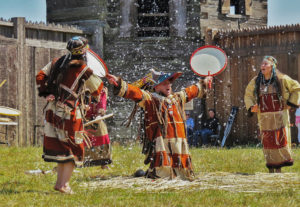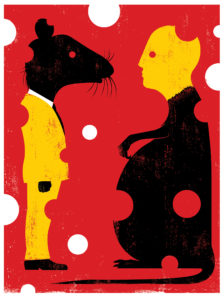from “The Farallon Islands” by Charles Nordhoff
The Farallon Islands, or “Los Farallones de los Frailes” (the rocky islets of the Brothers), were named in 1769 by explorer Juan Francisco de Bodega for the Franciscan monks of California’s missions. Beginning in 1810, Russian and American sealers devastated northern fur seal populations here. Then the Gold Rush created an insatiable market for seabird eggs, and “eggers” collected an estimated 14 million murre eggs by 1890. Travel writer Charles Nordhoff visited at the height of the pillage and described it for Harper’s New Monthly in 1874. The islands, declared a national wildlife refuge in 1907, are once again the setting for abundant wildlife scenes such as this—minus the eggers.
If you approach the harbor of San Francisco from the west, your first sight of land will be a collection of picturesque rocks known as the Farallones, or, more fully, the Farallones de los Frayles. They are six rugged islets, whose peaks lift up their heads in picturesque masses out of the ocean, twenty-three and a half miles [sic] from the Golden Gate, the famous entrance of San Francisco Bay.
These lonely rocks are filled with animal life; for they are the home of a multitude of sea-lions, and of vast numbers of birds and rabbits. The rabbits, which live on the scanty herbage growing among the rocks, are descended from a few pair brought here many years ago, when some speculative genius thought to make a huge rabbit-warren of these rocks for the San Francisco market.
The sea-lions, which congregate by thousands upon the cliffs, and bark and howl and shriek and roar in the caves and upon the steep sunny slopes, are but little disturbed, and one can usually approach within twenty or thirty yards. At a little distance they look like huge maggots, and their slow, ungainly motions do not lessen this resemblance.
As I sat, fascinated with this weird spectacle of the sea-lions, which seemed to me like an unhallowed prying into some hidden and monstrous secret of nature, I could better realize the fantastic and brutal wildness of life in the earlier geological ages, when monsters and chimeras dire wallowed about our unripe planet, and brute force of muscles and lungs ruled among the populous hordes of beasts which, fortunately for us, have perished, leaving us only this great wild sea-beast as a faint reminiscence.
All the islands are frequented by birds; but the largest, the South Farallon, on which the light-house stands, is the favorite resort of these creatures, who come here in astonishing numbers every summer to breed; and it is to this island that the eggers resort at this season to obtain supplies of sea-bird’s eggs for the San Francisco market, where they have a regular and large sale.
The birds which breed upon the Farallones are gulls, murres, shags [cormorants], and sea-parrots [puffins], the last a kind of penguin. The eggs of the shags and parrots are not used, but the eggers destroy them to make more room for the other birds. There has been, I was assured by the manager, no sensible decrease in the number of the birds or the eggs for twenty years.
From fifteen to twenty men are employed during the egging season in collecting and shipping the eggs. They live on the island during that time in rude shanties near the usual landing-place. The work is not amusing, for the birds seek out the least accessible places, and the men must follow, climbing often where a goat would almost hesitate.
So difficult is the ground that it is impossible to carry baskets. The egger therefore stuffs the eggs into his shirt, then clambers over rocks and down precipices to a place of deposit, where he puts them into baskets, to be carried to the shore. But so skillful and careful are the gatherers that but few eggs are broken.
The gathering proceeds daily, when it has once begun, and the whole ground is carefully cleared off, so that no stale eggs shall remain. Thus if a portion of the ground has been neglected for a day or two, all the eggs must be flung into the sea, so as to begin afresh. The gathering of eggs is stopped entirely about a month before the birds usually leave the island, so as to give them all an opportunity to hatch out a brood.

.jpg)



